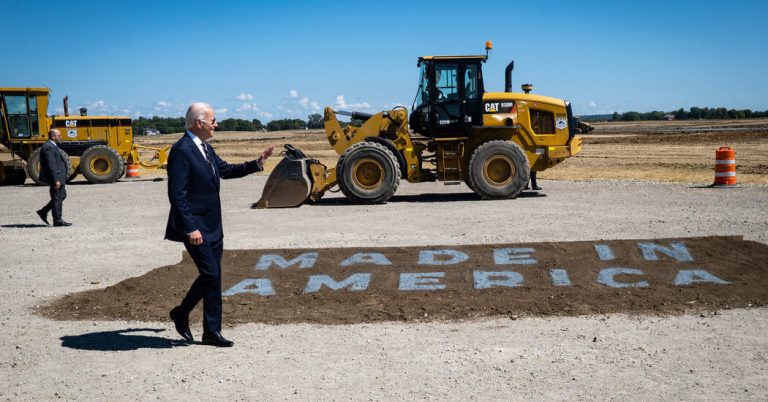The Biden administration awarded $504 million on Tuesday to a dozen projects across the country in an effort to turn previously overlooked communities into tech powerhouses.
The grants will fund “technology hubs” that aim to boost the production of critical technologies in areas such as western Montana, central Indiana, southern Florida and upstate New York. The hubs are intended to accelerate the development of advanced industries in the United States, such as biomanufacturing, clean energy, artificial intelligence and personalized medicine.
The program reflects a federal effort to expand funding for America’s science and technology beyond Silicon Valley and some coastal regions, an initiative that Biden administration officials say will help revitalize areas that have traditionally received less government investment. Supporters say the projects will help create “good-paying” jobs and tap underutilized worker groups and resources across the country.
The $10 billion program was authorized by the CHIPS and Science Act, which Congress passed in 2022 to boost domestic semiconductor manufacturing and increase funding for scientific research. The idea of spreading tech funding beyond Silicon Valley helped the legislation win broader support from lawmakers representing parts of the country eager to benefit.
The Commerce Department initially reviewed nearly 400 applications, narrowing them down to a pool of 31 projects that received “technology hub” designations in October. On Tuesday, 12 districts won grants ranging from $19 million to $51 million.
It is unclear, however, how much more funding will be available. Although Congress authorized $10 billion for the five-year program when the CHIPS Act was passed, only about $541 million — or about 5 percent — has been appropriated so far, which some say could hinder the program’s success.
John Lettieri, managing director of the Economic Innovation Group, a Washington think tank, said a lack of funding was a major hurdle for the program and that he was skeptical the awards would lead to meaningful transformation in these areas. He said that while the Biden administration was not to blame for the limited funding, he would prefer to see officials make “big bets on a smaller number of promising emerging technologies and sites,” rather than smaller grants spread across a dozen regions.
“We are not likely to achieve major technological breakthroughs as a result of this half a billion dollars,” Mr. Lettieri said, adding that the funds “will gradually help strengthen these areas, but will not lead to transformative results.”
Mark Muro, a senior fellow at the Brookings Institution, said the funding was a “significant advance” but that additional funding is needed to see a more significant economic transformation in these regions. Mr. Muro said he was “not entirely pessimistic” about the prospect of additional money, given the bipartisan interest in the program. But he said it would be a challenge because of political tensions that have made government spending a contentious issue on Capitol Hill.
“There is hope for further investment, but nothing is easy at the moment,” Mr Muro said.
Commerce Department officials said they would be willing to offer additional rounds of funding if lawmakers appropriate more money for the program.
“Simply put: We can do more with more,” Commerce Secretary Gina M. Raimondo said in a statement. “With more funding, we’ll make more awards, leading to more technological advancements, more regional growth and many more good-paying jobs.”
One of the beneficiaries on Tuesday was a project in Tulsa, Okla., that aims to develop drones and other autonomous systems for customers including the US military. Tulsa is home to a drone port with labs that can replicate various weather conditions for testing drones.
Jennifer Hankins, CEO of Tulsa Innovation Labs, which is leading the $51 million Tulsa project, said the initiative will help reduce the country’s reliance on foreign manufacturing for autonomous technologies and their components.
He also said the project will focus on addressing the issue of cultural bias in artificial intelligence systems, working with Native American tribal nations and black business organizations, among others. “Tulsa has been intentional about who we partner with to address this challenge,” he said.
Another winning project came from an Indiana consortium called Heartland BioWorks, which pledged $51 million to invest in biotechnology and biomanufacturing, including human, animal and plant life sciences.
Andrew Kossack, executive vice president for partnerships at the Institute for Applied Research, which is leading the Indiana project, said the tech hub will draw on local advantages such as the presence of pharmaceutical company Eli Lilly, a network of contract drug manufacturers and other companies focused on in plant and animal science.
“The Tech Hubs program was designed to leverage industrial clusters like we have here in Indiana in the biotech space,” he said. The money would put those industry groups on the map for venture capital and other financing that they might not otherwise be able to invest “in what some might consider ‘flyover country,'” he said.




